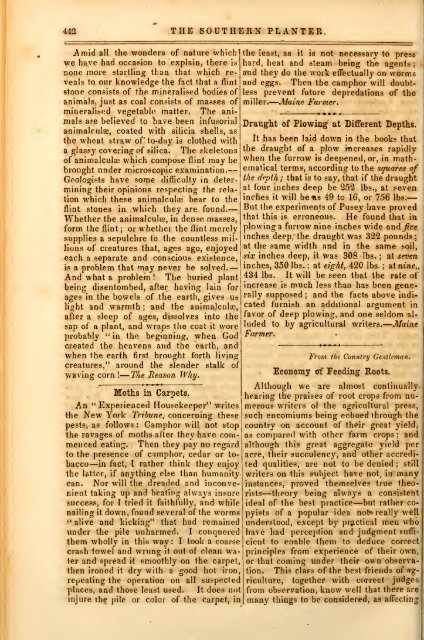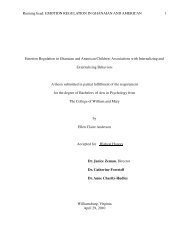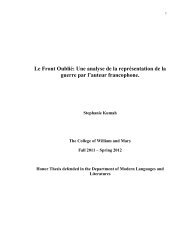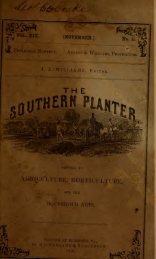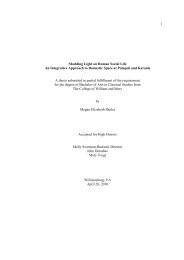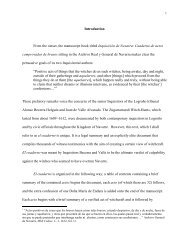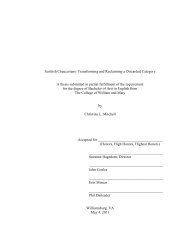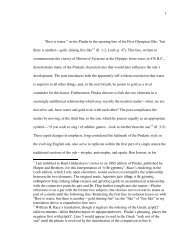Southern planter : devoted to agriculture, horticulture, and the ...
Southern planter : devoted to agriculture, horticulture, and the ...
Southern planter : devoted to agriculture, horticulture, and the ...
Create successful ePaper yourself
Turn your PDF publications into a flip-book with our unique Google optimized e-Paper software.
442 THE SOUTHEKN PLANTER.<br />
Amid al! <strong>the</strong> wonders of nature which<br />
we have had occasion <strong>to</strong> explain, <strong>the</strong>re is<br />
none inore startling than that which reveals<br />
<strong>to</strong> our knowledge <strong>the</strong> fact that a flint<br />
s<strong>to</strong>ne consists of <strong>the</strong> mineralised bodies of<br />
animals, just as coal consists of masses of<br />
mineralised vegetabh^ matter. The animals<br />
are believed <strong>to</strong> have been infusojial<br />
animalculae, coated with silicia shells, as<br />
<strong>the</strong> wheat straw of ' <strong>to</strong>-dny is clo<strong>the</strong>d with<br />
a glassy covering of silica. Tlie skele<strong>to</strong>ns<br />
of animalculag which compose flint may be<br />
brought under microscopic examination.<br />
Geologists have some difficulty in determining<br />
<strong>the</strong>ir opinions respecting <strong>the</strong> rela-<br />
tion which <strong>the</strong>se animalculce bear <strong>to</strong> <strong>the</strong><br />
flint s<strong>to</strong>nes in which <strong>the</strong>y are found.<br />
Whe<strong>the</strong>r <strong>the</strong> animalculje, in dense masses,<br />
form <strong>the</strong> flint ; or whe<strong>the</strong>r <strong>the</strong> flint merely<br />
supplies a sepulchre <strong>to</strong> tlie countless millions<br />
of creatures that, ages ago, enjoyed<br />
each a separate <strong>and</strong> conscious existence,<br />
is a problem that may never be solved.<br />
And what a problem ! The<br />
buried plant<br />
being disen<strong>to</strong>mbed, after having lain for<br />
ages in <strong>the</strong> bowels of <strong>the</strong> earth, gives us<br />
light <strong>and</strong> w^armth ; <strong>and</strong> <strong>the</strong> animalcules,<br />
after a sleep of ages, dissolves in<strong>to</strong> <strong>the</strong><br />
sap of a plant, <strong>and</strong> wTaps tiie coat it wore<br />
probably " in <strong>the</strong> beginning, when God<br />
created <strong>the</strong> heavens <strong>and</strong> <strong>the</strong> earth, <strong>and</strong><br />
when <strong>the</strong> earth first brought forth living<br />
creatures," around <strong>the</strong> slender stalk of<br />
waving corn ! T/ie Reason Why.<br />
Moths in Carpets.<br />
An "Experienced Housekeeper" writes<br />
<strong>the</strong> New York Tribune, concerning <strong>the</strong>se<br />
pests, as follows: Camphor will not s<strong>to</strong>p<br />
<strong>the</strong> ravages of moths after <strong>the</strong>y have commenced<br />
eating. Then <strong>the</strong>y pay no regard<br />
<strong>to</strong> <strong>the</strong> presence of cimphor, cedar or <strong>to</strong>bacco<br />
— in fact, t ra<strong>the</strong>r think <strong>the</strong>y enjoy<br />
<strong>the</strong> latter, if anything else than humanity<br />
can. Nor will <strong>the</strong> dreaded <strong>and</strong> inconvenient<br />
taking up <strong>and</strong> beating always insure<br />
success, for I tried it faithfully, <strong>and</strong> while<br />
nailing it down, found several of <strong>the</strong> worms<br />
" alive <strong>and</strong> kicking" that had remained<br />
under <strong>the</strong> pile unharmed. I conquered<br />
<strong>the</strong>m wholly in this way: I <strong>to</strong>ok a coarse<br />
crash <strong>to</strong>wel <strong>and</strong> wrung it out of clean wa-<br />
ter <strong>and</strong> spread it smoothly on <strong>the</strong> carpet,<br />
<strong>the</strong>n ironed it dry with a good hot iron,<br />
repeating <strong>the</strong> operation on all suspected<br />
places, <strong>and</strong> those least used. It does not<br />
injure ihe pile or color of <strong>the</strong> carpet, in<br />
<strong>the</strong> least, as it is not<br />
necessary <strong>to</strong> press<br />
hard, heat <strong>and</strong> steam being <strong>the</strong> _^ ,<br />
aiid <strong>the</strong>y do <strong>the</strong> work efl^ectually on worms<br />
<strong>and</strong> eggs. Then <strong>the</strong> camphor will doubtless<br />
prevent future depredations of <strong>the</strong><br />
miller. Maine Farmer.<br />
Draught of Plowing at Different Depths.<br />
It has been laid down in <strong>the</strong> books that<br />
<strong>the</strong> draught of a plow increases rapidly<br />
when <strong>the</strong> furrow is deepened, or, in ma<strong>the</strong>matical<br />
terms, according <strong>to</strong> <strong>the</strong> squares of<br />
<strong>the</strong> depth ; that is <strong>to</strong> say, that if <strong>the</strong> draught<br />
at four inches deep be 252 lbs., at seven<br />
inches it w^ill befis 49 <strong>to</strong> 16, or 756 lbs.<br />
But <strong>the</strong> experiments of Pusey have proved<br />
that this is erroneous. He found that in<br />
plowing a funow nine inches wide <strong>and</strong>^re,<br />
inches deep, <strong>the</strong> draught was 322 pounds.;<br />
at <strong>the</strong> same width <strong>and</strong> in <strong>the</strong> same soil,<br />
six inches deep, it was 308 lbs. ; at seven<br />
inches, 350 lbs. ; at eight, 420 lbs. ; atmwe,.<br />
434 lbs. It will be seen that <strong>the</strong> rate of<br />
increase is much less than has been gene*<br />
rally supposed ; <strong>and</strong> <strong>the</strong> facts above indicated<br />
furnish an additional argument in<br />
favor of deep plowing, <strong>and</strong> one seldom alluded<br />
<strong>to</strong> b}^ agricultural writers. Maine<br />
Farmer.<br />
From <strong>the</strong> Country Gentleman.<br />
Economy off Feeding Roots.<br />
Although we are almost continually,<br />
hearing <strong>the</strong> praises of root crops from numerous<br />
writers of <strong>the</strong> agricultural press,<br />
such encomiums being echoed through <strong>the</strong><br />
country on account of <strong>the</strong>ir great yield,<br />
as compared with o<strong>the</strong>r farm crops ; <strong>and</strong><br />
although this great aggregate yield per<br />
acre, <strong>the</strong>ir succulency, <strong>and</strong> o<strong>the</strong>r accredi-<br />
ted qualities, are not <strong>to</strong> be denied ; still<br />
writers on this subject have not, in many<br />
instances, proved <strong>the</strong>mselves true <strong>the</strong>orists—<strong>the</strong>ory<br />
being alwnys a consistent<br />
ideal of <strong>the</strong> best practice—but ra<strong>the</strong>r copyists<br />
of a popular idea not> really well<br />
unders<strong>to</strong>od, except by practical men who<br />
have had perce})tion <strong>and</strong> judgment suffi-<br />
cient <strong>to</strong> enable <strong>the</strong>m <strong>to</strong> deduce correct<br />
principles from experience of <strong>the</strong>ir own,<br />
or that coming under <strong>the</strong>ir own observation.<br />
This class of <strong>the</strong> best friends of <strong>agriculture</strong>,<br />
<strong>to</strong>ge<strong>the</strong>r with correct judges<br />
from observation, know w^ell that <strong>the</strong>re are<br />
many things <strong>to</strong> be considered, as affecting


